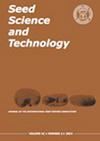Invited Review: Mimicking the natural thermal environments experienced by seeds to break physiological dormancy to enhance seed testing and seedling production
IF 3
4区 农林科学
Q2 AGRONOMY
引用次数: 7
Abstract
Physiological dormancy (PD) is the most common class of seed dormancy on earth. It is highly variable and is an important part of the adaptation of many species to their habitat. Often, two questions are asked about seeds that failed to germinate in a germination test: (1) are they non-viable or dormant, and (2) if dormant do they have PD and how is it broken? We provide an overview on how to approach studies of species with PD for which few or no data are available. Information about habitat environmental conditions during the seed stage can be used to formulate hypotheses on dormancy-breaking and germination requirements. These hypotheses can be tested by a move-along experiment. There are three levels of PD, and they are distinguished by the conditions required to break PD and promote germination. Seeds with non-deep PD (the most common level of PD) require different conditions for dormancy-break and germination, i.e. a change in the season, while those with intermediate and deep PD germinate at the dormancy-breaking conditions, e.g. during a long period of cold stratification. Knowing how to break PD enhances testing for seed viability and helps ensure high germination percentages of viable seeds.特邀评论:模拟种子所经历的自然热环境,打破生理休眠,以提高种子测试和幼苗生产
生理休眠(PD)是地球上最常见的种子休眠类型。它是高度可变的,是许多物种适应其栖息地的重要组成部分。通常,对于在发芽试验中未能发芽的种子,人们会问两个问题:(1)它们是不活的还是处于休眠状态,(2)如果处于休眠状态,它们是否有PD,它是如何被破坏的?我们提供了一个概述,如何接近的物种与PD的研究很少或没有数据可用。种子期的生境环境条件信息可以用来制定关于休眠打破和发芽要求的假设。这些假设可以通过移动实验来验证。PD有三个级别,它们是根据打破PD和促进萌发所需的条件来区分的。非深度PD(最常见的PD水平)的种子需要不同的休眠和萌发条件,如季节的变化,而中等和深度PD的种子在休眠打破条件下萌发,如长时间的冷分层。了解如何打破PD提高了对种子活力的测试,并有助于确保高发芽率的活种子。
本文章由计算机程序翻译,如有差异,请以英文原文为准。
求助全文
约1分钟内获得全文
求助全文
来源期刊

Seed Science and Technology
农林科学-农艺学
CiteScore
3.00
自引率
28.60%
发文量
36
审稿时长
>36 weeks
期刊介绍:
Seed Science and Technology (SST) is an international journal featuring original papers and articles on seed quality and physiology related to seed production, harvest, processing, sampling, storage, genetic conservation, habitat regeneration, distribution and testing. A journal that meets the needs of researchers, advisers and all those involved in the improvement and technical control of seed quality. Published every April, August and December.
 求助内容:
求助内容: 应助结果提醒方式:
应助结果提醒方式:


